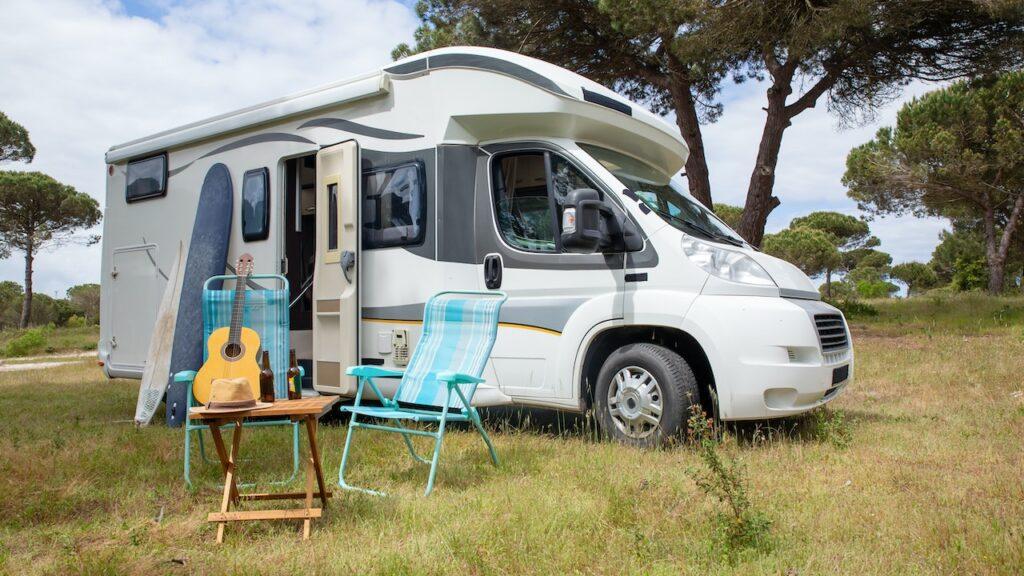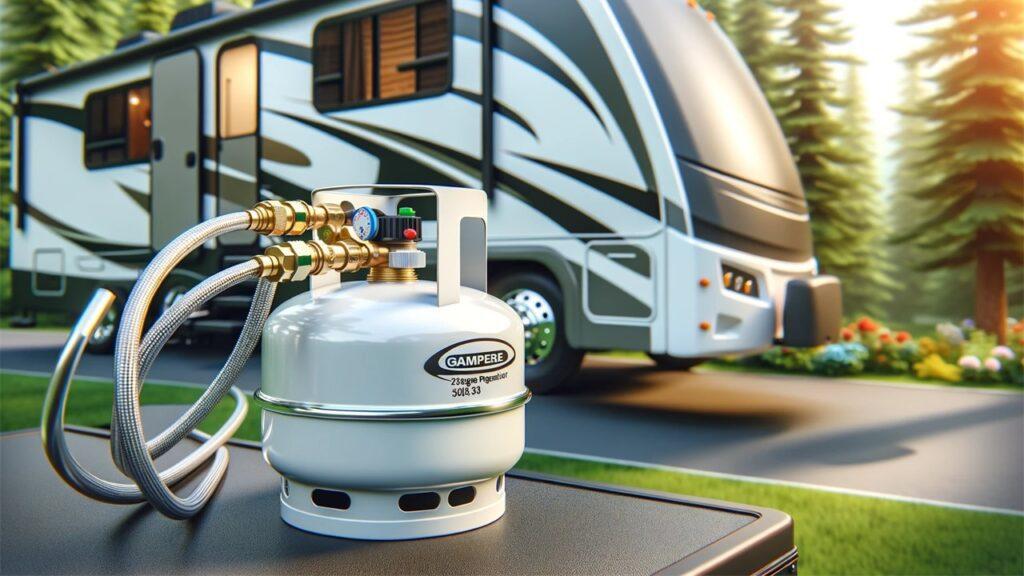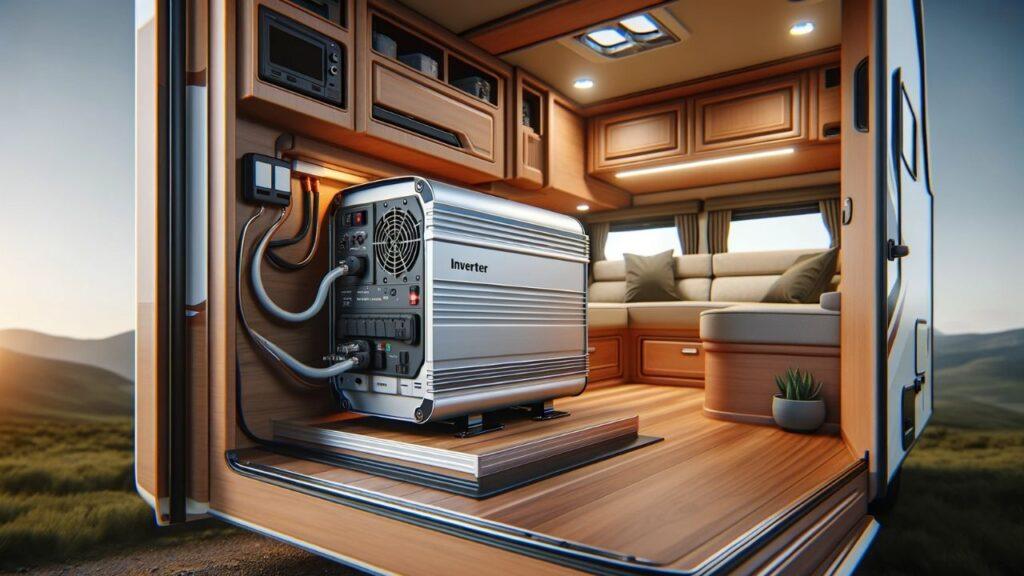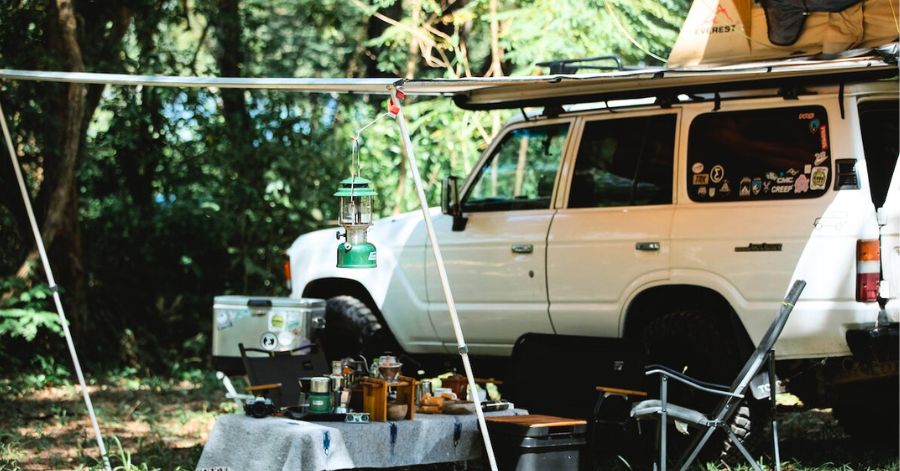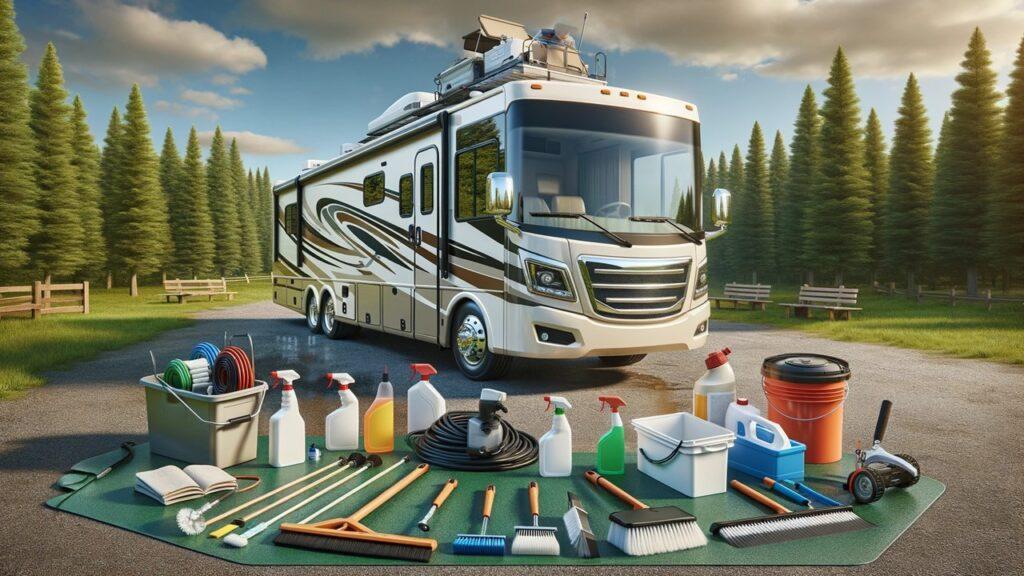
Whether you’re gearing up for a summer adventure or preparing for the long haul, understanding the importance of regular RV roof maintenance is key. RV roofs, crafted from materials like rubber, fiberglass, or metal, each come with their unique care demands. In “How To Clean and Maintain RV Roof,” we’ll dive deep into these materials. Furthremorem, outlining not just why they matter but how they can be preserved. Additionally, a well-maintained roof ensures your home on wheels remains sturdy and leak-free, ready for wherever the road may lead. So, let’s set the stage for a hassle-free journey with a roof that’s in top-notch condition.
RV Roof Type Materials and Their Specific Care Needs
When it comes to maintaining your RV, the roof might just be the most crucial component to keep in check. After all, it shields you from the elements, ensuring that your travels are safe and your living space remains dry. In this detailed exploration, we’ll dissect the most common RV roof materials—rubber, fiberglass, and metal—and discuss the specific care each requires. By understanding these materials, you’ll be better equipped to protect your investment and enjoy stress-free adventures on the road.
Types of RV Roofs
Rubber (EPDM and TPO)
Rubber roofs, particularly those made from EPDM (Ethylene Propylene Diene Monomer) and TPO (Thermoplastic Polyolefin), are famed for their durability and flexibility. This makes them ideal for withstanding the environmental stresses that come with life on the road. Caring for a rubber roof involves regular cleaning with a mild soap and water solution to prevent the buildup of dirt and debris. Additionally, you should inspect them for any signs of punctures or wear, particularly after a bustling summer or harsh winter. Applying a UV-resistant coating can also extend the life of an EPDM or TPO roof, safeguarding your RV from the sun’s harsh rays.
Fiberglass
Fiberglass roofs are important for their sleek appearance and resistance to corrosion and UV damage. These roofs are sturdier and less prone to scratching than their rubber counterparts. To maintain a fiberglass roof, regular washing with a specifically designed fiberglass cleaner will help maintain its glossy finish and prevent oxidation. Periodic waxing is also recommended to enhance its protective layer, which helps in repelling water and dirt, keeping the RV looking new.
Metal
Metal roofs, often made from aluminum or coated steel, are the champions when it comes to durability. They are especially resistant to tearing and less susceptible to leaks. If not properly cared they can be prone to rust and corrosion. Regular inspections are crucial to catch any signs of rust early, and treating the roof with anti-rust compounds can prevent future issues. Washing a metal roof requires a gentler approach to avoid scratching the surface, with periodic application of a metal protector to enhance its shine and protective qualities.
Why Different Materials Require Different Care
Each roofing material reacts uniquely to environmental conditions and thus demands a tailored approach to maintenance. Rubber roofs, for instance, are particularly vulnerable to UV damage and can become brittle and crack if not regularly treated with protective coatings. Fiberglass, while more resilient, can dull and become more brittle over time due to oxidation if not regularly polished and maintained. Metal roofs face the risk of corrosion and rust, which can compromise their integrity and lead to leaks if neglected.
Moreover, the lifespan and durability of your RV’s roof are directly tied to how well you adhere to these care guidelines. Regular maintenance not only extends the life of the roof but also helps in maintaining the overall value of your RV. By investing time in understanding and caring for your RV roof, you’re not just maintaining a component of your vehicle; you’re preserving your home away from home.
Navigating the care needs of different RV roof materials isn’t just about keeping up appearances or avoiding leaks; it’s about ensuring that your mobile abode remains safe and comfortable, no matter where you park it. Whether you’re tucked away in a cozy RV park or out braving the rugged terrains of a boondocking site, the care you put into your roof safeguards your RV’s interior, your possessions, and most importantly, your peace of mind during your adventures. With this knowledge in hand, you’re well on your way to becoming a savvy RV owner, ready for whatever the road throws your way.
How to Inspect Your RV Roof for Damage
When it comes to your RV, the roof is your first line of defense against the elements, making regular inspections a must for maintaining your mobile sanctuary. With each change of season, or before embarking on a new adventure, a thorough check of your RV’s rooftop can prevent unforeseen issues from dampening your travels. Here, we’ll guide you through identifying potential problems and the necessary tools for a comprehensive inspection, ensuring your RV remains ready for the road ahead.
What to Look For During Inspection
Initiating a roof inspection? Start with a keen eye for signs of wear, such as cracks and leaks. These small nuisances can escalate into significant concerns if water infiltrates and damages both the roof and your RV’s interior. Examine the sealant around fixtures like vents and skylights too; any lifting or cracking might call for a quick reseal to keep moisture out.
Furthermore, feel for softer spots on the roof’s surface—these could indicate water damage lurking beneath. Tackling these issues swiftly not only preserves your RV’s roof but also enhances your on-the-road comfort and safety. By staying ahead of maintenance, you extend the life of your RV and ensure it remains a reliable, cozy haven for all your travels.
Tools and Safety Equipment Needed for Roof Inspection
Safety first! Ensure you’re well-equipped with the proper tools and safety gear before climbing up for a closer look. A robust ladder, preferably one made of reinforced aluminum or fiberglass, will provide steady access to your RV. Don’t forget a safety harness, particularly if you’re inspecting post-rain; RV roofs can be surprisingly slick.
Your inspection toolkit should include essentials like a caulking gun for fresh sealant applications, a utility knife for trimming away old sealant, and a soft brush for clearing debris. Non-slip shoes and durable gloves will enhance your grip and protect your hands as you work.
Just as you would maintain other critical components of your RV—from ensuring the RV’s air conditioners are operational to checking the RV’s fresh water tanks—keeping a vigilant eye on your roof is key to stress-free adventures. Regular inspections are as crucial as any other maintenance routine, allowing you to spot potential problems early and tackle them before they escalate.
Properly inspecting and maintaining your RV roof isn’t just about upkeep—it’s about peace of mind. Knowing that your RV is in top shape lets you focus on what really matters: enjoying your journeys, exploring new horizons, and making unforgettable memories. Armed with the right tools and knowledge, you’re all set to ensure that your home away from home stays safe and sound, no matter where the road takes you.
Cleaning Your RV Roof: Step-by-Step Guide
A clean RV roof not only looks good but also extends the lifespan of your mobile home by protecting it from the elements. Regular cleaning is crucial, especially after long trips or when transitioning between seasons. T. With the right approach, you can keep your roof in pristine condition and ensure it continues to protect your RV year after year.
Preparing for Cleaning
Before diving into the cleaning process, it’s essential to prepare the area and gather the necessary supplies. Start by clearing the roof surface of any debris like leaves, twigs, or dirt that can scratch the roof while cleaning. This step is crucial to avoid damaging the protective coatings on your roof. Make sure your RV is parked in a shaded area or on a cool day to prevent cleaning agents from drying too quickly, which can leave residues.
Selecting the Right Cleaning Agents and Tools
Choosing the appropriate cleaning agents and tools is vital for effective cleaning without damaging your RV roof. For most roofs, a mild, non-abrasive soap mixed with water will do the trick. Avoid harsh chemicals that can degrade the roofing material. Use a soft-bristle brush or a sponge to apply the solution; these tools are gentle enough to prevent scratches but robust enough to remove dirt and grime.
How to Properly Clean Different Types of RV Roofs
Rubber roofs require careful handling to avoid damaging their protective layer. Use a cleaner specifically designed for EPDM or TPO roofs. Apply the cleaning solution gently with a soft brush, working in sections to ensure thorough coverage without letting the soap dry on the surface. Rinse thoroughly with water to remove any soap residue, which can attract more dirt if left behind.
Fiberglass roofs are more resilient but still require gentle cleaning techniques to maintain their glossy finish. Use a fiberglass-specific cleaner to help preserve the roof’s integrity and enhance its shine. Apply the cleaner with a soft sponge, and rinse well with water. You can also apply a quality wax post-cleaning to protect the roof from UV damage and to repel dirt more effectively.
Metal roofs stand up well to harsher conditions but can be susceptible to corrosion if not properly maintained. Use a cleaner that’s safe for metal and apply with a non-metallic brush to avoid scratching the surface. Pay special attention to rinsing off all cleaning agents completely to prevent corrosion and rust.
Handling Stubborn Stains and Avoiding Common Cleaning Mistakes
Stubborn stains on any roof type require a bit more attention. For tough spots, a solution of water and baking soda can be effective, especially on rubber and fiberglass roofs. Apply the mixture and let it sit for a few minutes before scrubbing gently. Always avoid using abrasive tools or scrubbing too hard, as these can cause irreversible damage to the roof surface.
Moreover, one common mistake is neglecting to check the weather before starting your cleaning project. Ensure there’s no rain forecasted that could wash away your cleaning agents before they’ve been properly rinsed off. Another mistake is ignoring the seams and edges of the roof, where dirt and grime can accumulate and lead to leaks if not cleaned regularly.
A well-maintained RV roof is key to enjoying your travels without unexpected disruptions. By following these detailed cleaning steps, you can ensure your RV remains in top condition, safeguarding your investment and enhancing your on-the-road experiences. Whether you’re parked in a serene RV park or preparing for your next adventure, taking the time to clean your RV roof can lead to years of happy and safe traveling.
Essential Maintenance to Extend the Life of Your RV Roof
A well-kept roof not only prevents water damage and insulation problems but also ensures that your RV remains sturdy and comfortable, no matter your destination. In this section, we delve into the regular maintenance tasks that should be on every RV owner’s checklist and discuss when it’s time to call in professional help for more complex roof maintenance issues.
Regular Maintenance Tasks
Regular maintenance of your RV roof is crucial for ensuring its longevity and functionality. Begin by regularly checking and cleaning the gutters and downspouts to prevent water buildup, which can lead to leaks and water damage. It’s also important to inspect the seals and caulking around vents, air conditioning units, and other fixtures. Any signs of cracking or wear should be addressed promptly with the appropriate sealants, which will prevent moisture from seeping into vulnerable areas.
Furthermore, apply a UV-resistant treatment to your roof at least once a year. UV exposure can significantly degrade materials like rubber and fiberglass, leading to brittleness and cracks. This simple step can greatly enhance the roof’s resistance to the sun’s harsh rays. Also, make it a routine to check for any loose screws or hardware, and tighten them as needed to ensure everything is securely attached and watertight.
When to Seek Professional Help for RV Roof Maintenance
While many aspects of RV roof maintenance can be handled on your own, there are times when professional assistance is necessary. If you encounter extensive damage, such as large tears or deep cracks, it’s wise to consult with a professional. They can assess the damage thoroughly and perform repairs that might be beyond the scope of typical DIY fixes. Moreover, if you notice persistent leaks despite your best efforts to seal and repair your roof, professional help can ensure that underlying issues are addressed properly.
Additionally, if your RV has been subjected to severe weather conditions like hail or fallen branches, a professional inspection can help ensure that all damage is identified and addressed. They can also offer advice on enhancing your roof’s resilience against future incidents, possibly recommending upgrades or materials that better suit your specific travel and climate conditions.
Regular maintenance and timely professional intervention are key to keeping your RV roof in optimal condition. By staying vigilant and proactive about roof care, you can protect your investment and enjoy your travels without worry. Whether you’re exploring sunny coastlines or traversing rainy mountain passes, a well-maintained roof ensures your RV remains a safe, dry, and cozy haven on wheels. So, take the time to inspect, maintain, and, when necessary, seek professional help to keep your roof—and your RV adventures—smooth and enjoyable.
How to Repair Common Issues with RV Roofs
Every RV owner will face roof issues at some point, but knowing how to address them effectively can save you time and money. From minor damage that can be easily fixed to more significant issues requiring professional intervention, understanding how to repair your RV roof is an essential skill for any road warrior. This guide will provide detailed instructions on handling both minor and major roof repairs, ensuring that your RV remains in top shape for all your adventures.
DIY Repairs for Minor Damage
For minor RV roof damage, such as small leaks or tears, DIY repairs can be a quick and cost-effective solution. Start by thoroughly cleaning the area around the damage using a mild cleaner to ensure the repair materials adhere properly. For small holes or tears, applying a patch of EPDM or TPO membrane (depending on your roof type) with a suitable adhesive can seal the damage effectively. Ensuring the well-sealing of edges and give the adhesive ample time to cure.
Additionally, reapplying sealant around fixtures and joints annually can prevent leaks and further damage. Use a high-quality sealant compatible with your roofing material to fill any cracks or gaps found during your regular inspections. Such preventative measures not only fix existing problems but also help avoid new ones.
What to Do When Major Repairs Are Needed
When facing major damage, such as extensive leaks, structural damage from fallen debris, or severe deterioration, it’s important to assess whether professional repairs needs. Large-scale damage often requires more complex solutions, such as complete roof overlays or replacement of large sections, which might necessitate specialized tools and materials.
Furthermore, consulting with a professional can provide insights into the extent of the damage and the best repair methods. They can ensure that all aspects of the repair meet industry standards and extend the lifespan of your RV roof. In cases where insurance claims may be involved due to the damage, professional assessments and repairs can also facilitate smoother claims processing.
Whether tackling minor repairs yourself or assessing when to bring in a professional, staying informed about your RV roof’s condition is crucial. Regular maintenance checks and timely repairs ensure that your RV continues to provide a safe and comfortable shelter on your journeys, keeping minor issues from becoming major headaches. By being proactive about roof care, you can focus more on enjoying your travels and less on worrying about overhead.
Benefits of Regular RV Roof Maintenance
Regular maintenance of your RV’s roof isn’t just about preventing leaks; it’s a crucial practice that boosts both the longevity and functionality of your traveling home. Think of it as a shield for your RV, one that, when well-maintained, protects not just the roof itself but everything beneath it.
First off, routine care extends your roof’s durability, enabling it to withstand diverse weather conditions—from blistering heat to icy cold. This upkeep helps prevent the gradual wear that can escalate into serious damage, ensuring that your RV remains robust over the years. Moreover, a sound roof maintains the integrity of your RV’s interior. Without proper maintenance, you could face leaks that lead to costly repairs due to water damage, mold, and even structural weakness.
Additionally, a well-sealed and intact roof significantly enhances your RV’s energy efficiency. It keeps the interior temperature stable, reducing the need for heating or air conditioning to compensate for air leaks. This not only cuts down on energy costs but also makes your RV a more comfortable environment, no matter where you park it.
Lastly, preserving the condition of your roof can also safeguard the resale value of your RV. A roof in good shape suggests meticulous upkeep and can be a compelling selling point, potentially boosting the market value of your RV.
In essence, investing in regular roof maintenance means investing in the health and happiness of your RV lifestyle. It ensures that your adventures remain uninterrupted by unexpected breakdowns, keeping you on the road in comfort and style. Regular checks and timely repairs are not just maintenance tasks; they’re peace of mind on wheels.
Wrapping It Up!
Wrapping up our journey through the essentials of RV roof maintenance, it’s evident that the roof is more than just an overhead barrier—it’s a critical asset that demands your attention and care. From understanding the different materials that make up your roof to mastering the steps for effective cleaning, regular maintenance, and tackling both minor and major repairs, we’ve covered what every RV owner needs to know to keep their vehicle in top condition.
The importance of regular roof maintenance is very important for RV. It prevents expensive repairs, prolongs the lifespan of your RV, and enhances your living experience on the road. Maintaining your roof ensures the safety and integrity of your RV’s interior and boosts energy efficiency, which translates into a more comfortable environment, no matter where your travels take you.
Moreover, making roof maintenance a part of your regular RV care routine is a wise investment in your vehicle’s longevity and value. Whether you’re planning short getaways or long-term adventures, your RV is your home on the go. Like any home, it requires a commitment to upkeep that keeps it safe, comfortable, and ready for whatever the road throws your way.
In essence, consistent care and maintenance of your RV roof will pave the way for smooth and enjoyable travels. So, embrace the routine checks, keep your maintenance tools handy, and treat your RV roof with the care it deserves. Your adventures—and your RV—will be all the better for it.
Related FAQs
Can I Use Pressure Washers on My RV Roof?
No, using pressure washers can damage the roof’s material. Stick to soft brushes and gentle cleaning solutions.
How Often Should I Inspect My RV Roof?
Inspect your RV roof at least twice a year and after any severe weather events.
What Is the Right Sealant for RV Roofs?
The right sealant depends on your roof type, but typically, self-leveling lap sealants are recommended for most RV roofs.
How Can I Prevent Mold on My RV Roof?
Regular cleaning and ensuring your roof is dry before storing your RV can prevent mold growth.
Is It Necessary To Repaint My RV Roof?
Repainting is not usually necessary but applying a UV-resistant coating can help protect and extend the life of the roof.

Jack Rivers is a long-time RVer, a husband, and a dad who’s traveled solo and now with his family. He’s learned a lot from years on the road, sometimes the hard way. From quiet mornings parked by the woods to messy evenings with the kids and a busted heater, he’s been through it all. Miles writes to share the real stuff, the small wins, and the lessons that make RV life worth it, no matter who you’re traveling with.

